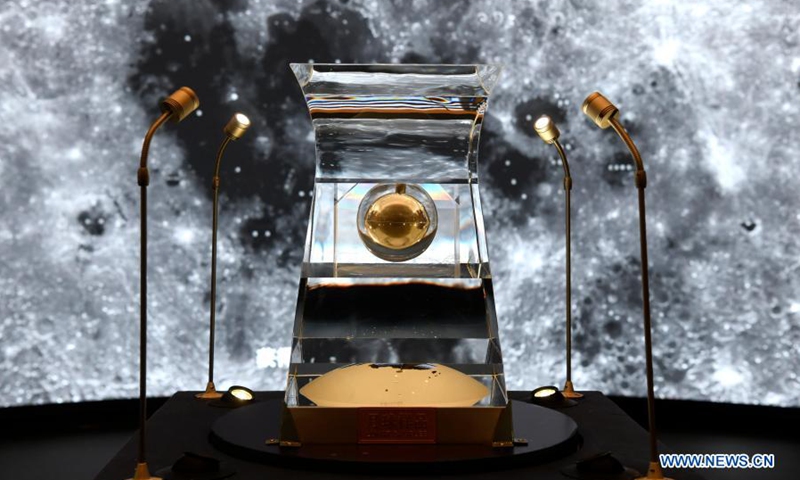SCI-TECH / AIR & SPACE
China’s space industry continues on extensive intl exchanges, sharing and cooperation: CASC

The lunar samples No. 001 brought back by China's Chang'e-5 probe is displayed at the National Museum of China in Beijing, capital of China, Feb. 27, 2021. An exhibition displaying the lunar samples No. 001 brought back by China's Chang'e-5 probe is held here on Saturday.(Photo: Xinhua)
According to the China Aerospace Science and Technology Corp (CASC), a state-owned conglomerate and the nation's leading space contractor, China's aerospace industry has facilitated extensive exchanges, data sharing, and technology cooperation with the international community over the past year. These efforts have propelled the joint high-quality development of the Belt and Road Initiative and furthered the goal of building a community with a shared future for humanity.
According to a statement the CASC provided to the Global Times on the sidelines of the ongoing two sessions, the year of 2023 has witnessed numerous milestones in terms of China’s space multilateral and bilateral cooperation.
China released to the international community the Rules for Management of International Cooperation in Lunar Samples and Scientific Data in August, 2023.
The country also announced that it would soon open international applications for research samples from the Chang'e-5 lunar mission, and released an announcement on the international cooperation opportunities for the Chang'e-8 mission, aiming to promote joint research, applications, and international sharing of scientific achievements.
Additionally, the Asia-Pacific Space Cooperation Organization, and countries including Venezuela, Azerbaijan, Pakistan, Belarus, South Africa, Egypt, and others have joined the China-proposed International Lunar Research Station (ILRS) program in 2023, per the CASC.
The BeiDou Navigation Satellite System, the country’s by-far largest space-borne infrastructure also known as the BDS, has also officially joined the standards of the International Civil Aviation Organization of the UN in the year.
The International Civil Aviation Organization has recognized China’s BDS as a secure, comprehensive, and reliable satellite navigation system, incorporating it into its standards to provide safe and effective services for global civil aviation.
The BDS has become one of four global satellite navigation systems recognized by the UN, along with the United States' GPS, Russia's GLONASS and the European Union's Galileo. It currently serves users in more than 200 countries and regions worldwide.
China’s homegrown Fengyun meteorological satellites are also contributing strength to the global disaster prevention and relief and to the sustainable development worldwide.
According to the CASC, the developers of the Fengyun satellites, the satellites which serve as a duty satellite for the International Charter on Space and Major Disasters, has been conducting monitoring and analysis of global weather, climate, ecological environment, major disasters, and major incidents.
Throughout the 2023, it issued more than 300 reports on global satellite remote sensing monitoring services. Newly registered countries for the International Users of Fengyun Meteorological Satellite for Disaster Prevention and Mitigation Mechanism include Pakistan and Côte d'Ivoire, bringing the total to 34 countries. And in 2023, Fengyun satellites have responded to 28 emergency service requests from all over the world.
In the field of satellite remote sensing, China’s data sharing and cooperative exchanges continue to advance. China has launched a platform to build a national and comprehensive remote sensing resource sharing and application services system.
The first group of user units includes the National University of Laos, Jagannath University in Bangladesh, the BioSense Institute in Serbia, and the National Space Research and Technology Center of Kazakhstan, and the development has been hailed a milestone in further enhancing the contribution and accessibility of Chinese remote sensing data to countries worldwide, especially in developing countries.
The China-Africa Satellite Remote Sensing Application Cooperation Center has been established in 2023 to carry out cooperation in data sharing, development of public products, satellite remote sensing dynamic monitoring and demonstration applications, personnel training, and exchanges. It serves African countries in the fields of digital economy, poverty reduction, disaster prevention and mitigation, natural resource monitoring, water resource utilization, and ecological environment protection, the CASC explained.
In terms of bilateral cooperation, China has inked multiple cooperation treaties and memorandums of understanding (MoUs) with countries including Algeria, Venezuela, Pakistan and Egypt in the past year.
China’s National Space Administration (CNSA) and the Algerian Space Agency signed the "2023-2027 China-Algeria Space Cooperation Outline." Both parties vowed to deepen cooperation in areas such as lunar and deep space exploration, satellite communication, Earth observation, space infrastructure, training, and exchanges.
CNSA also signed a framework agreement on space cooperation with Venezuela, focusing on space science, international lunar research stations, satellite development, satellite data and applications, ground stations, launch services, and personnel training.
Additionally, the CNSA signed a memorandum of understanding with Pakistan on space debris and space traffic management cooperation, contributing significantly to the development of the two countries' all-weather strategic partnership.
Furthermore, CNSA signed memorandums of understanding and cooperation agreements with Egypt to conduct joint research and development cooperation in lunar and deep space exploration, spacecraft development and launch, space infrastructure construction, satellite data reception and application, BRICS remote sensing satellite constellation, space science, and astronomical observation. Cooperation in spacecraft development, testing, and assembly continues to be promoted.
The EgyptSat-A, jointly designed and developed by China and Egypt, was successfully launched in 2023, marking the first international cooperative satellite project under the comprehensive assistance mode, which will further improve Egypt's industrial system from satellite development, ground facility construction and operation, to satellite data processing, sharing, and application.
Moreover, China and Europe achieved the first-ever full-satellite joint assembly and satellite-launch vehicle integrated test in 2023.
The team of the Solar wind Magnetosphere Ionosphere Link Explorer or known as by its mission code name SMILE, conducted joint satellite-sample launch vehicle tests at the European Space Agency, completing interface docking, satellite separation, and impact tests.
According to the CASC blue paper for 2023 that was released by February 2024, the China-French astronomical satellite (SVOM), will also make its launch in 2024.

